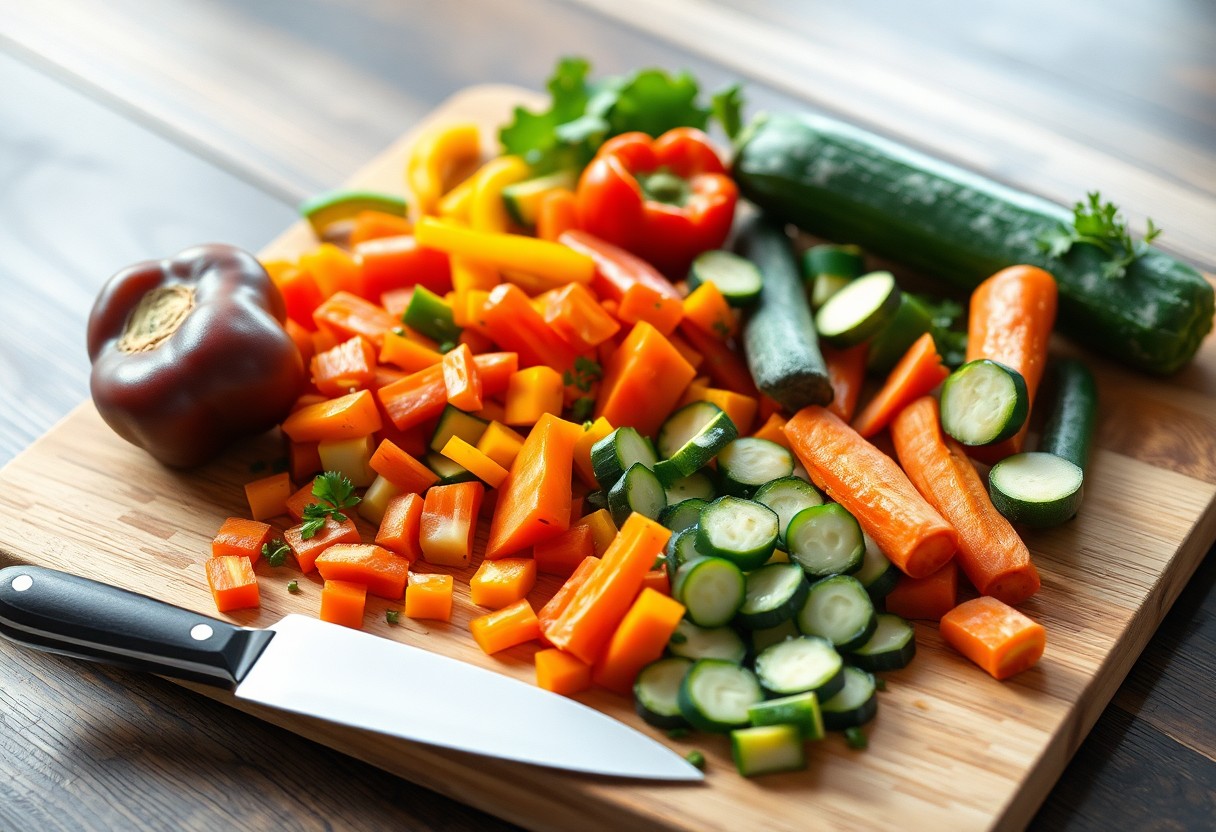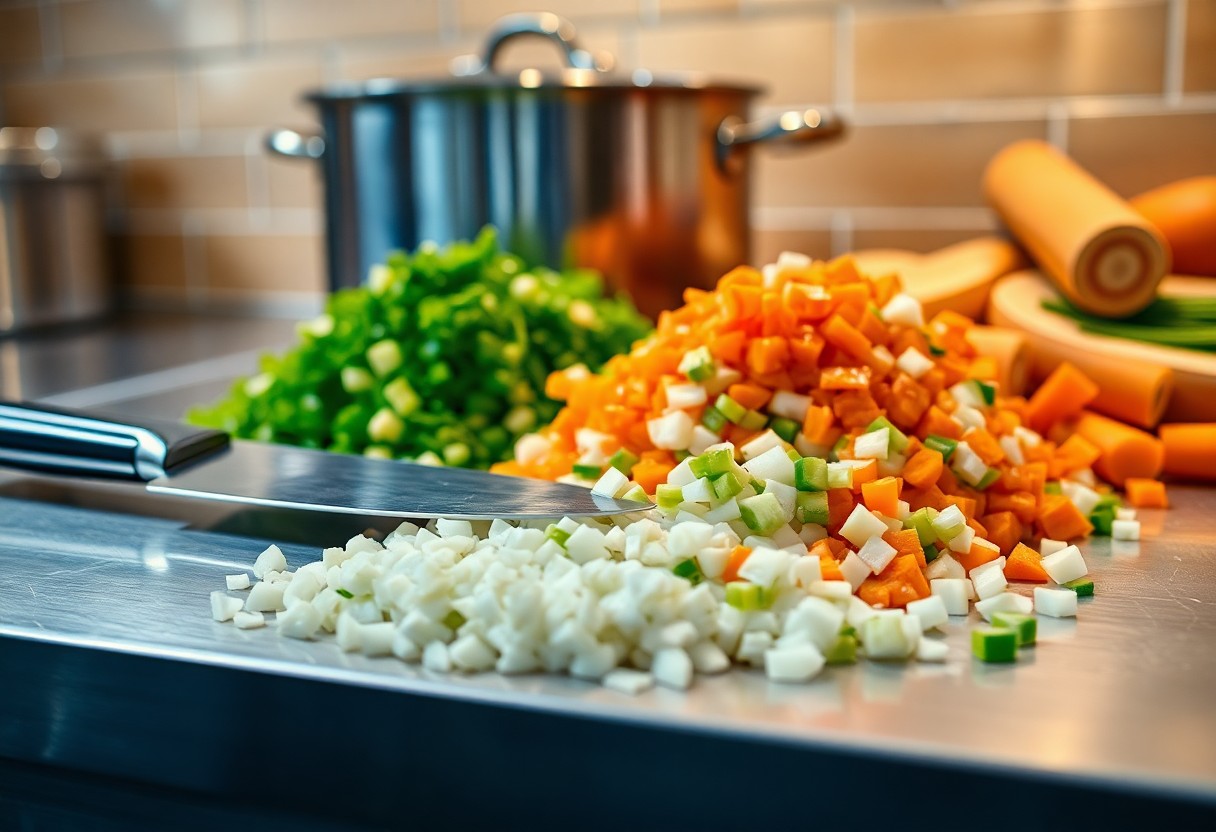Chopping vegetables can dramatically impact the texture and flavor of your dishes. By understanding how to cut each type of vegetable according to your cooking style, you enhance the taste and achieve even cooking. Proper knife techniques not only improve your efficiency but also ensure your safety in the kitchen. This guide will equip you with the skills to chop vegetables in ways that are tailored to different culinary methods, ensuring your meals are both delicious and visually appealing.
Key Takeaways:
- Different cooking styles require specific vegetable cuts for optimal flavor and texture.
- Uniform sizing allows for even cooking and enhances the visual appeal of dishes.
- Knife skills improve efficiency in the kitchen and reduce preparation time.

Understanding Vegetable Knife Skills
Mastering vegetable knife skills enhances your culinary precision and efficiency. When you wield your knife with confidence, you not only increase the safety of your prep work but also elevate the overall presentation and flavor of your dishes. By honing your techniques, you’ll truly understand how different cutting styles impact the cooking process and outcomes.
Essential Knives for Chopping
Your kitchen arsenal should include a chef’s knife, ideal for most chopping tasks, along with a paring knife for peeling and intricate work. A slicing knife can be valuable for larger vegetables, while a utility knife offers versatility for various sizes and shapes. Investing in quality knives will make a significant difference in both your efficiency and enjoyment of food preparation.
Basic Vegetable Cuts and Techniques
Familiarizing yourself with fundamental vegetable cuts can dramatically enhance your cooking. Basic techniques include the dice, julienne, and mirepoix. Each technique opens the door to diverse texture and flavor experiences in your dishes, like how a finely minced garlic becomes aromatic when sautéed compared to coarser pieces.
Start with a standard dice for uniform pieces that cook evenly, perfect for soups and stews. A julienne cut creates long, thin strips, ideal for stir-fries or salads, while the mirepoix technique combines onions, carrots, and celery, forming a flavorful base for countless recipes. Each technique demands practice to ensure consistency and safety; mastering them will not only streamline your cooking process but also allow you to experiment creatively with flavors and presentations.
Chopping for Stir-Frying
When you chop vegetables for stir-frying, precision plays a key role. Cutting vegetables into uniform pieces ensures that they cook at the same rate, resulting in a dish that boasts both appealing texture and consistent flavor. Whether you prefer a fine julienne or a thicker slice, achieving a similar size across all ingredients is vital for optimal heat distribution.
Uniform Cuts for Even Cooking
Creating uniform cuts is vital for even cooking. When each piece is the same size, you’ll prevent instances of overcooked or undercooked vegetables. For stir-frying, aim for 1-inch pieces or thinner, depending on the vegetable, to allow quick cooking and caramelization while preserving crunchiness.
Recommended Vegetable Choices
In the context of stir-frying, opt for vegetables that retain their texture when cooked quickly. Bell peppers, broccoli, snap peas, and carrots are excellent choices, as they combine crispness with vibrant flavors. Starchy vegetables, such as potatoes, may not be ideal, as they require longer cooking times to achieve tenderness.
Among the best vegetable choices, bell peppers provide color and sweetness, while broccoli adds a nutritious crunch. Snap peas introduce a fresh snap, perfectly complementing proteins. Carrots enhance your stir-fry’s sweetness and can be sliced thinly to cook quickly. For a balanced stir-fry, consider incorporating these selections for both visual appeal and varied textures, ensuring your dish is both satisfying and nutritious.

Dicing for Soups and Stews
Dicing vegetables for soups and stews requires attention to size and consistency to promote even cooking and maximize flavor absorption. Precise dicing allows the vegetables to release their natural juices, creating a rich base for your dish. Aim for uniform cubes, typically around half an inch, so they cook evenly and meld seamlessly with other ingredients, enhancing the overall texture and taste of your hearty meal.
The Importance of Dice Size
The size of your vegetable dice significantly impacts the cooking time and texture of your final dish. Smaller pieces cook faster, while larger cubes take longer, influencing how well they absorb surrounding flavors. If you aim for a robust, well-blended flavor, keeping your dice around half an inch ensures everything melds nicely without overcooking some ingredients while others remain underdone.
Ideal Vegetables for Stewing
When stewing, certain vegetables shine due to their ability to hold up during the long cooking process. Potatoes, carrots, and parsnips are excellent choices, as they become tender yet retain their shape. Additionally, vegetables like onions and celery provide foundational flavor, while beans and lentils add protein and texture, making for a balanced and satisfying stew.
Incorporating vegetables such as butternut squash, turnips, and even mushrooms can elevate your stew by adding complex flavors and a variety of textures. While potatoes thicken the broth and absorb flavors, carrots provide natural sweetness. Onions and garlic enhance your stew’s aroma, creating a comforting and inviting dish. Always consider seasonal vegetables to add freshness and a distinct touch to your stews, making each preparation unique and tailored to available ingredients.
Slicing for Salads and Fresh Dishes
When preparing vegetables for salads and fresh dishes, the focus shifts to achieving crispness and vibrant color. Slicing ensures that flavors meld while maintaining the integrity of each ingredient. Uniform slices add to the visual appeal, allowing for a harmonious mix of textures that enhance your dining experience. Thinly sliced vegetables like cucumbers or bell peppers can add crunch, while larger pieces of tomatoes or avocados provide creaminess, making every bite a delight.
Techniques for Perfect Slices
To achieve perfect slices, use a sharp chef’s knife and practice the rocking motion. This technique allows you to guide the knife effortlessly through the vegetable, creating even slices. A mandoline slicer can also be beneficial for achieving consistent thickness, especially for items like radishes or carrots. Prioritize your safety by ensuring the blade is sharp and using a cut-resistant glove when necessary.
Best Vegetables for Raw Consumption
Not all vegetables are created equal when it comes to enjoying them raw. Cucumbers, bell peppers, and carrots are top choices due to their refreshing flavors and crunchy textures. Additionally, cherry tomatoes provide a burst of sweetness, while radishes add a peppery bite. Incorporating a mix of these vegetables not only boosts nutrition but also introduces a satisfying variety of taste and texture.
When deciding on vegetables for raw dishes, prioritize those with high water content and fiber, which aid digestion and contribute to a refreshing crunch. For instance, cucumbers are composed of about 95% water, making them hydrating and light. Additionally, bell peppers are rich in vitamins A and C, enhancing both the flavor profile and nutritional value of your salad. Combining vibrant colors and distinct flavors, these raw vegetables can turn any salad into a nutritious and visually appealing dish.
Mincing for Sauces and Marinades
Mincing enhances the flavor of sauces and marinades by incorporating finely chopped ingredients that diffuse their taste and aroma more deeply. This technique is imperative for maximizing the impact of aromatic vegetables, ensuring your dishes are vibrant and full-bodied. Whether you’re preparing a zesty vinaigrette or a rich pasta sauce, the art of mincing transforms ordinary recipes into extraordinary culinary experiences.
Proper Mincing Techniques
To achieve a fine mince, start by chopping your vegetables into small, even pieces for uniformity. Utilize a rocking motion with your knife, maintaining a grip on the blade’s tip and applying pressure with your other hand to guide the food. Aim for a texture that’s less than a quarter-inch across; this maximizes surface area, allowing the flavors to meld and blend seamlessly as they cook.
Flavorful Vegetables for Mincing
For impactful mincing, focus on aromatic vegetables like garlic, onions, shallots, and ginger. Each of these ingredients contributes a distinct flavor profile that elevates your sauces and marinades. Garlic brings pungency, onions offer sweetness, while ginger introduces warmth and zest, enhancing overall complexity.
Using a combination of these vegetables adds depth to your minced mixture. For example, finely minced garlic and ginger in a soy sauce-based marinade create a robust flavor punch, making your dishes irresistibly savory. Likewise, a mix of onions and shallots infuses a sweet undertone, balancing acidity in vinaigrettes. Explore your palate by experimenting with herbs like cilantro or basil added at the end for a fresh burst of flavor, giving your sauces and marinades an exciting edge.
Special Techniques for Specific Cultures
Cultural cooking styles often dictate specific chopping techniques that enhance flavors and presentation. Embracing these techniques not only enriches your culinary repertoire but also allows you to appreciate global cuisines. By tailoring your chopping methods to align with cultural practices, you can elevate your dishes and achieve authenticity in your cooking.
Asian Chopping Styles
In Asian cuisines, chefs utilize techniques such as the claw grip for safety and precision while chopping. Dominating the knife with a swift, fluid motion, they create thin slices, juliennes, or diced pieces-ideal for stir-fries and soups. Techniques like the rocking motion are employed, allowing for consistent sizes that maximize flavor release.
Mediterranean Preparation Methods
Mediterranean cooking emphasizes the importance of texture and flavor, necessitating varied chopping techniques. You often dice, mince, or slice vegetables to complement dishes like ratatouille or tabbouleh. These methods not only enhance visual appeal but also allow for optimal flavor melding, creating a harmonious balance in each dish.
When preparing Mediterranean meals, focus on chopping techniques that highlight the freshness of ingredients. For instance, finely dicing tomatoes and cucumbers for tabbouleh allows their flavors to intermingle, while slicing bell peppers thinly for a caponata creates an inviting texture. Using herbs like parsley or basil, finely chopped, adds a fragrant note to your dishes. Aim for rustic cuts that reflect the region’s culinary traditions, ensuring each bite is infused with vibrant Mediterranean essence.
Final Words
With this in mind, mastering the art of chopping vegetables tailored to different cooking styles enhances your culinary skills and elevates your dishes. Whether you’re julienning for a stir-fry or dicing for a hearty stew, understanding each technique allows you to maximize flavor and texture in your meals. By applying these methods, you not only improve your efficiency in the kitchen but also express creativity, ensuring that every meal is not just nutritious but also visually appealing. Embrace these skills to refine your approach to cooking and enjoy the process of preparing delicious food.
FAQ
Q: What is the best way to chop vegetables for a stir-fry?
A: For stir-frying, vegetables should be cut into uniform, bite-sized pieces to ensure even cooking. Use a chef’s knife for precision and aim for thin strips or small cubes, depending on the vegetable type.
Q: How should I prepare vegetables for roasting?
A: When roasting, vegetables should be cut into larger pieces, typically about 1-2 inches, to enhance caramelization. This size allows for a nice balance between tenderness and a crisp exterior when cooked at high temperatures.
Q: What technique is recommended for chopping vegetables for soups?
A: For soups, chop vegetables into small, even pieces, usually around 1/2 inch. This allows for quick cooking and a meld of flavors. A rough chop can be used for heartier soups, while finer cuts work well for creamy textures.
Q: How do I chop vegetables for salads efficiently?
A: For salads, slice vegetables thinly or cut them into small, uniform pieces to enhance texture and flavor distribution. A mandoline can be helpful for consistent thickness, while a sharp knife ensures clean cuts.
Q: What are some tips for chopping herbs for various dishes?
A: When chopping herbs, use a sharp knife to minimize bruising. For fine chopping, stack the leaves, roll them tightly, and slice thinly. For garnishing, larger, whole leaves can be used to retain flavor and freshness.
